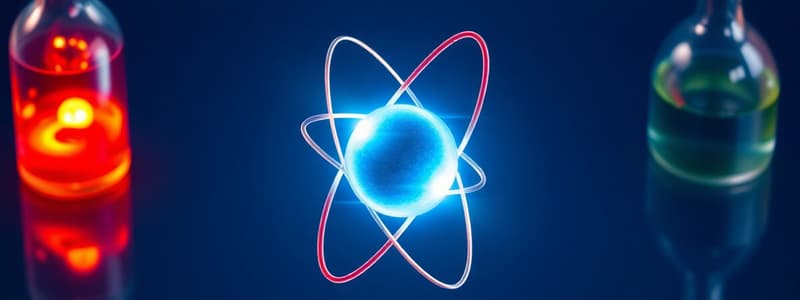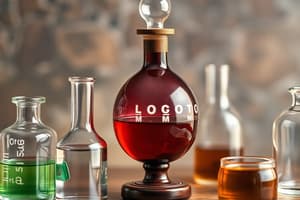Podcast
Questions and Answers
The number of protons in an atom is equal to the ______ number.
The number of protons in an atom is equal to the ______ number.
atomic
The sum of the number of protons and neutrons in an atom is called the ______.
The sum of the number of protons and neutrons in an atom is called the ______.
atomic mass
Valence electrons are the ______ electrons of an atom.
Valence electrons are the ______ electrons of an atom.
outermost
The Law of Conservation of Mass states that mass cannot be ______ or destroyed in a chemical reaction.
The Law of Conservation of Mass states that mass cannot be ______ or destroyed in a chemical reaction.
The ______ rule indicates that an atom must have eight valence electrons to be stable.
The ______ rule indicates that an atom must have eight valence electrons to be stable.
Radioactive isotopes undergo a process of ______ or release of subatomic particles.
Radioactive isotopes undergo a process of ______ or release of subatomic particles.
Nuclear power plants produce ______% of the electricity used in the US.
Nuclear power plants produce ______% of the electricity used in the US.
Many smoke detectors contain a radioactive ______ source.
Many smoke detectors contain a radioactive ______ source.
Democritus proposed the existence of the ______.
Democritus proposed the existence of the ______.
Ernest Rutherford discovered the ______.
Ernest Rutherford discovered the ______.
John Dalton's theory states that all substances are made of ______.
John Dalton's theory states that all substances are made of ______.
Niels Bohr proposed that electrons travel around the nucleus in ______.
Niels Bohr proposed that electrons travel around the nucleus in ______.
According to Rutherford, the small, dense, positively charged particle present in the nucleus is called a ______.
According to Rutherford, the small, dense, positively charged particle present in the nucleus is called a ______.
Aristotle believed there was no limit to the number of times matter could be ______.
Aristotle believed there was no limit to the number of times matter could be ______.
Erwin Schrödinger developed the ______ model.
Erwin Schrödinger developed the ______ model.
In Dalton's Model, atoms are described as ______ spheres.
In Dalton's Model, atoms are described as ______ spheres.
J.J. Thomson discovered the first subatomic particles known as ______.
J.J. Thomson discovered the first subatomic particles known as ______.
James Chadwick discovered ______ in 1932.
James Chadwick discovered ______ in 1932.
The atomic mass unit (amu) is the unit of measurement for ______ particles.
The atomic mass unit (amu) is the unit of measurement for ______ particles.
According to Dalton's Atomic Theory, all matter is made up of ______.
According to Dalton's Atomic Theory, all matter is made up of ______.
In stable atoms, the number of protons is equal to the number of ______.
In stable atoms, the number of protons is equal to the number of ______.
The type of atom is determined by the number of ______ it has.
The type of atom is determined by the number of ______ it has.
Isotopes have different numbers of ______.
Isotopes have different numbers of ______.
The electron, proton, and neutron are the three main ______ particles.
The electron, proton, and neutron are the three main ______ particles.
Flashcards
Atomic Number
Atomic Number
The number of protons in an atom, determining its chemical identity.
Atomic Mass
Atomic Mass
The sum of protons and neutrons in an atom's nucleus, reflecting its mass.
Isotopes
Isotopes
Atoms of the same element with differing numbers of neutrons, resulting in different atomic masses.
Valence Electrons
Valence Electrons
Signup and view all the flashcards
Octet Rule
Octet Rule
Signup and view all the flashcards
Law of Conservation of Mass
Law of Conservation of Mass
Signup and view all the flashcards
Law of Definite Proportion
Law of Definite Proportion
Signup and view all the flashcards
Law of Multiple Proportions
Law of Multiple Proportions
Signup and view all the flashcards
Electron Cloud
Electron Cloud
Signup and view all the flashcards
Atom
Atom
Signup and view all the flashcards
Proton
Proton
Signup and view all the flashcards
Neutron
Neutron
Signup and view all the flashcards
Electron
Electron
Signup and view all the flashcards
Plum Pudding Model
Plum Pudding Model
Signup and view all the flashcards
Democritus's Atomic Theory
Democritus's Atomic Theory
Signup and view all the flashcards
Dalton's Atomic Theory
Dalton's Atomic Theory
Signup and view all the flashcards
Rutherford's Atomic Model
Rutherford's Atomic Model
Signup and view all the flashcards
Bohr's Atomic Model
Bohr's Atomic Model
Signup and view all the flashcards
Schrödinger's Electron Cloud Model
Schrödinger's Electron Cloud Model
Signup and view all the flashcards
Atomic Nucleus
Atomic Nucleus
Signup and view all the flashcards
Study Notes
Atomic Models Throughout History
-
Democritus (460 BC): Greek philosopher proposed the existence of atoms. He theorized atoms are small, hard particles made of a single material, differing in shape and size, and constantly moving.
-
Aristotle: Disagreed with Democritus, believing matter could be divided infinitely and composed of four fundamental elements (Earth, Fire, Water, Air).
-
John Dalton (1766-1844): British chemist proposed a revised atomic theory. His theory stated atoms cannot be created, divided, or destroyed; that atoms of the same element were identical, and atoms of different elements had different masses; and that atoms combined in specific ratios to form compounds. He also proposed the Solid Sphere Model.
-
J.J. Thomson (1856-1940): English physicist discovered the electron, a subatomic particle with a negative charge. This led to the Plum Pudding Model, where electrons were envisioned as embedded in a positively charged sphere.
-
Ernest Rutherford (1871-1937): New Zealand physicist conducted the gold foil experiment, demonstrating the existence of a dense, positively charged nucleus within atoms. Electrons orbit this nucleus. He discovered the proton. He proposed the nuclear model.
-
Niels Bohr (1913): Danish physicist improved the model by proposing that electrons orbit the nucleus in specific energy levels or shells. He discovered energy levels.
-
Erwin Schrodinger (1924): Austrian physicist developed the electron cloud model. This model describes electrons as existing in a probability cloud around the nucleus, not in fixed orbits. An electron can be anywhere within the 'cloud'.
-
James Chadwick (1932): English physicist discovered the neutron, a neutral subatomic particle in the nucleus, having roughly the same mass as a proton.
Atomic Structure and Composition
- Atoms are composed of three main subatomic particles: protons, neutrons, and electrons.
- Protons and neutrons are located in the nucleus of the atom, while electrons orbit the nucleus.
- The number of protons in an atom's nucleus identifies the element. This is the atomic number (Z).
- The sum of protons and neutrons is the mass number (A).
Atomic Number, Mass Number, and Isotopes
- Isotopes are atoms of the same element with different numbers of neutrons but the same number of protons.
- Isotopes have the same atomic number but different mass numbers.
Average Atomic Mass
- This number is weighted average of all isotopes of an element present in nature. It is calculated using the masses and abundances of the isotopes.
Studying That Suits You
Use AI to generate personalized quizzes and flashcards to suit your learning preferences.



